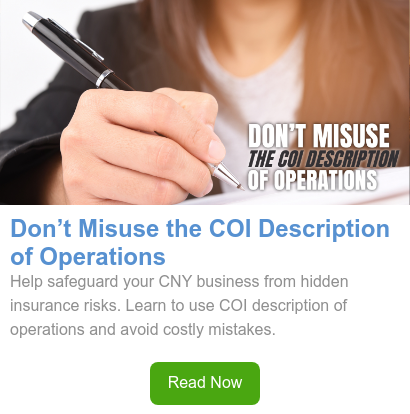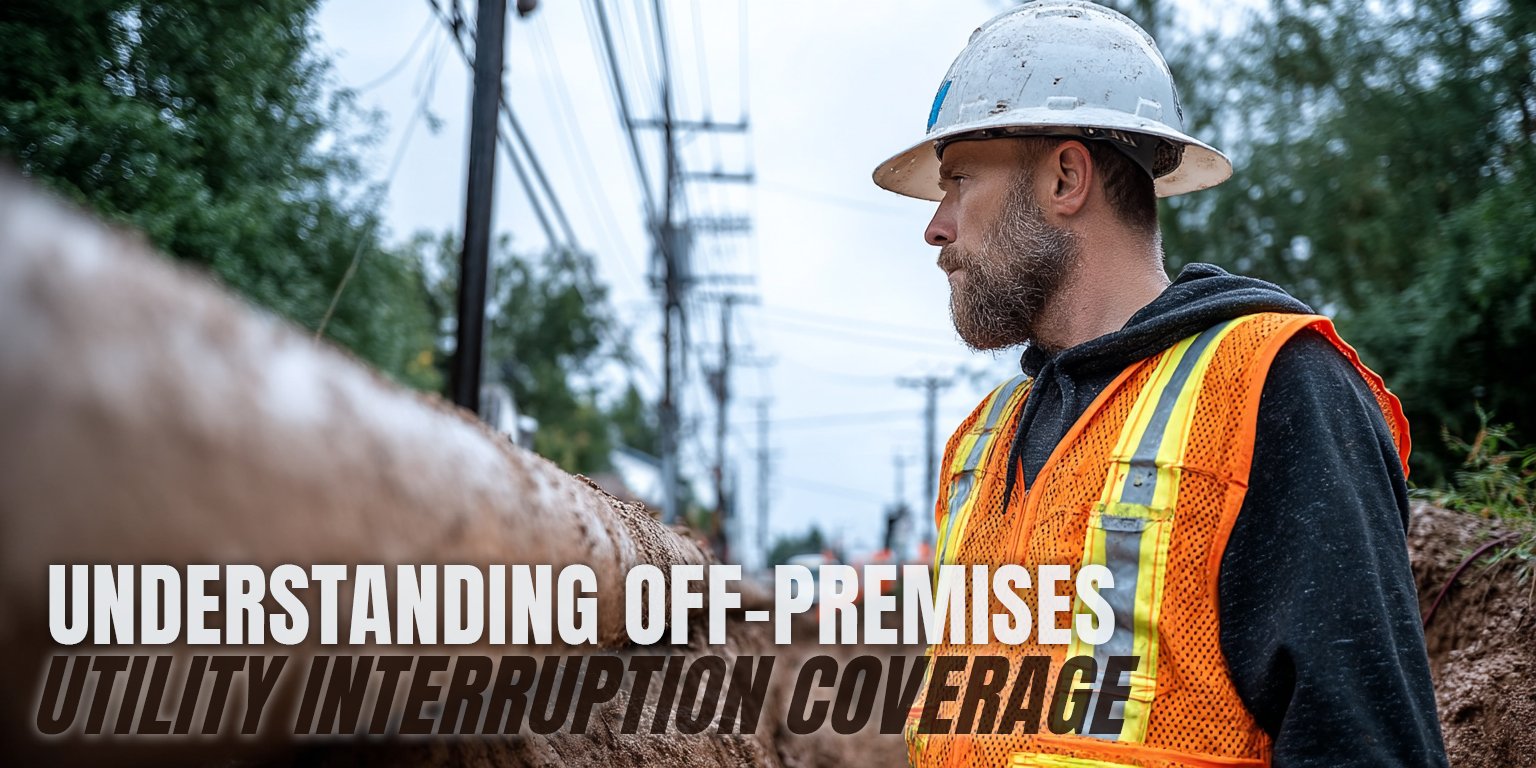Understanding Certificate of Insurance Limitations: What Central New York Businesses Should Know
August 18th, 2025
5 min read

You require certificates of insurance from every contractor, vendor, and service provider who works on your property or with your organization. You specify detailed language for the description of operations box, require multiple entities to be listed as additional insureds, and carefully review each certificate before approving work.
Despite these efforts, you might not be getting the value you think you're securing for your organization.
At the Horan insurance agency, we help businesses throughout the region understand how certificates of insurance work and what they do and don't provide. We work with multiple carriers to help businesses explore options and understand contractual insurance requirements.
In this article, we'll explore what certificates of insurance can realistically guarantee, why the description of operations box doesn't work the way many people think, and how to streamline your certificate requirements to focus on meaningful elements.
 Learning What Certificates of Insurance Can Provide
Learning What Certificates of Insurance Can Provide
Every certificate of insurance contains standard language at the top that many organizations overlook but that fundamentally affects what the certificate can and cannot do.
This language states that the certificate "is issued as a matter of information only and confers no rights upon the certificate holder" and that it "does not affirmatively or negatively amend, extend, or alter the coverage afforded by the policies below."
This disclaimer means that regardless of what appears elsewhere on the certificate, the document serves only as verification that policies existed on the date shown. The certificate cannot create provisions that don't exist in the actual policy, cannot extend benefits to entities not properly added to the policy, and cannot modify policy terms based on language in the description box.
Many business owners and risk managers have relied on certificates for years without learning this fundamental limitation. Past experiences where "everything worked out fine" don't necessarily mean the certificate provided the value you thought it did. It might mean you were fortunate enough to avoid situations where these limitations were tested.
Learning these limitations helps you focus your certificate requirements on what can provide value rather than creating elaborate language that offers no real benefit.
How the Description of Operations Box Functions
The description of operations box serves a specific purpose that differs significantly from how many organizations try to use it. This box is designed to describe the actual work being performed and where it's taking place, not to add additional insureds or modify policy terms.
A proper description might read: "ABC Landscaping to complete three-acre sod removal and reseeding of property located at 322 West North Street in Manlius." This description identifies the specific work and location involved in the project.
However, many organizations request language like: "XYZ Corporation and its employees and affiliates will be added as additional insured on this policy." This type of language doesn't accomplish what you might think it does. The certificate cannot add you to the policy simply because this language appears in the description box.
If the contractor changes the scope of work—perhaps deciding not to reseed after removing the sod—the policy doesn't automatically adjust to match the description box. The description serves as information only and doesn't create contractual obligations between you and the carrier.
More importantly, elaborate language in this box cannot override the disclaimer at the top of the certificate. The certificate remains a document that provides information only, regardless of what specific language appears in the description section.
Why Complex Additional Insured Language Creates Problems
Many organizations request certificates listing "ABC Company, its employees, officers, directors, affiliates, and subsidiaries" as additional insureds. This approach creates several problems that may reduce rather than increase your benefits.
When you separate employees from the company in your certificate language, you inadvertently create an opportunity for the carrier to argue that benefits don't extend properly to your organization. Your employees act on behalf of your company. They are your company for practical purposes. By listing them separately, you suggest they operate independently from your organization.
A corporation or LLC cannot physically cause damage. Only the people working for that organization can cause harm. When your organization is listed as an additional insured, benefits extend to your organization and the people acting on its behalf. Separating employees in the certificate language creates unnecessary complications that could affect benefits.
The term "affiliates" creates even broader problems. Affiliates could include any organization you have any connection with, from major corporations you do business with to trade associations you belong to. Policies cannot realistically extend benefits to unlimited affiliated organizations, especially when the contractor has no relationship with these entities.
This broad language doesn't create broader benefits—it creates confusion about what benefits exist and for whom.
Focusing on Elements That Provide Value in Certificate Requirements
Effective certificate requirements focus on three key questions:
- Does the contractor have adequate insurance?
- Is your organization properly listed as an additional insured?
- Are the limits sufficient for your comfort level?
The additional insured status appears in a specific checkbox on the certificate, not in the description of operations box. If this box is checked, your organization is listed as an additional insured. If it's not checked, you're not included, regardless of what language appears elsewhere on the certificate.
Limits appear clearly on the certificate, showing the amounts available for general liability, auto liability, workers compensation, and other types. These limits help you evaluate whether the contractor carries sufficient amounts for the work they're performing.
The certificate also confirms that policies were in place on the date shown, which helps with your record-keeping and compliance purposes.
Beyond these three elements, additional language and requirements typically don't provide meaningful value and may create confusion that could affect benefits in claim situations.
Avoiding Language That Creates More Risk Than Benefit
Some commonly requested certificate language may increase rather than decrease your risk exposure. Learning these pitfalls helps you create requirements that serve your needs.
Requesting specific policy language that doesn't appear in the actual policy creates unrealistic expectations. The certificate cannot modify policy terms or create benefits that don't exist in the underlying contract. If something goes wrong and you discover the benefits you thought existed weren't there, the fact that it appeared on a certificate won't bridge that gap.
Agents who write whatever language you request on certificates might be creating liability for themselves if claims arise and the benefits don't exist as described. This situation doesn't help you as the certificate holder, it just creates additional legal complications that won't resolve your gap.
The disclaimer language at the top of every certificate exists specifically to prevent certificates from creating obligations that don't exist in the policies. This language has legal standing and takes precedence over any other language that appears on the certificate.
Streamlining Your Certificate Process for Better Results
Effective certificate requirements focus on verification rather than creating elaborate language that doesn't provide real benefit. This approach reduces administrative burden while ensuring you get the information you need.
Instead of requesting detailed language in the description box, focus on whether the work scope generally matches what you've contracted for. Instead of listing multiple entities as additional insureds, focus on whether your primary organization appears in the additional insured checkbox.
Instead of requesting specific policy language modifications, focus on whether the limits provide adequate financial amounts for the work being performed.
This streamlined approach reduces back-and-forth communications with contractors and their agents while focusing attention on the elements that provide value for your risk management purposes.
When you encounter resistance to elaborate certificate language from contractors or their agents, consider that they might be helping both of you avoid creating unrealistic expectations about benefits that don't exist.
Making Certificate Requirements Work for Your Organization
Certificates of insurance serve an important purpose in verifying that contractors carry adequate insurance and that your organization is properly included. However, they work best when requirements focus on what certificates can provide rather than what many people think they should provide.
Learning the limitations of certificates helps you create requirements that provide real value while avoiding language that creates false confidence in benefits that don't exist. This approach may serve your organization more effectively than elaborate language that sounds comprehensive but provides no real benefit.
The Horan insurance agency helps businesses throughout the region understand how certificates of insurance work and what they can realistically provide. We can discuss how to structure certificate requirements that focus on meaningful verification while avoiding common pitfalls.
Click the Get a Quote button below to learn more about certificate requirements and how to structure them for meaningful verification.
Daniel is an accomplished content creator. He has been working in publishing for almost two decades. Horan Companies hired Daniel as its content manager in November 2022. The agency entrusted its messaging to him. Since then, Daniel has written insurance articles, service pages, PDF guides, and more. All in an effort to educate CNY readers. He's helping them understand the world of insurance so they can make informed decisions.
Topics:




























